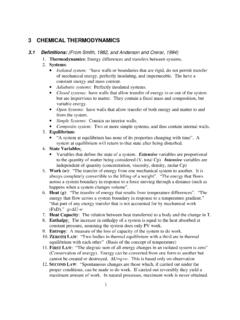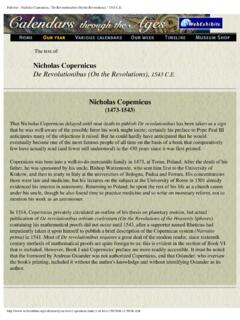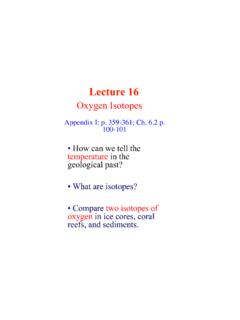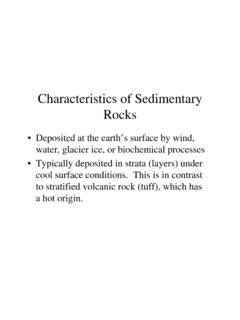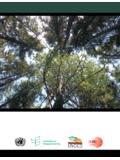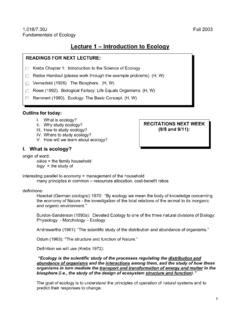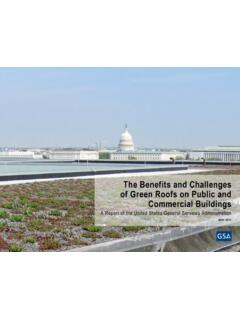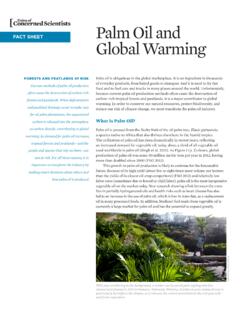Transcription of Anthropogenic Influences and Their Impact on Global Climate
1 Anthropogenic Influences and Their Impact on Global Climate By Ria Detmer GEO 387H Professor Yang November 18, 2008 Ria Detmer Literature Review 2 Abstract Scientist has raised some concerns with the current rise of temperature throughout the world. Researchers illustrate the correlation of environmental issues to Global warming due to Anthropogenic impacts. Environmental issues such as population growth, degradation of land and air pollution has influence the biogeochemical and biogeophysical process of the Climate system. This review focuses on five different researches on land use, land cover, physiological response of species to Climate change, tropical cyclones and, groundwater.
2 Analyzing these reports will help understand the effects of Climate change and Their association with one another. Introduction Anthropogenic activities are one of the primary causes of Global warming. Various types of ongoing research are being done to understand the relationship of human activities and Their Impact on Global Climate . Studies have shown that Climate temperature has been rising and it s causing for polar ice caps to melt at a quicker rate, intense weather phenomena, and rising sea level. With the growing population, it is necessary for researchers to assess the effects of land changes that are being made by humans.
3 In addition, natural process such as biogeochemical and biogeophysical process can influence Global Climate . Combining these factors can assist scientist in understanding how the elements Impact the ecological and biological aspect. The increase in Global temperature also impacts the sea surface temperature as well as water availabilities. Weather intensity has been rising in the recent years and researchers have put forth in understanding these weather trends. These type of phenomena much be carefully Ria Detmer Literature Review 3 researched and analyze to understand what types of factors that are creating these trends.
4 Understanding the causality of Global warming can help determine a sustainable plan. Land Use Amanda Barr conducted a research on the interconnectivity between land use and Global warming. She illustrates the influence of environmental issues through land degradation and its effects on the atmospheric and ocean temperature and its composition. As a result these environmental issues, Intergovernmental Panel on Climate Change (IPCC) reported that the earth s temperature will continue to rise over the course of 100 years due to the imbalance of incoming solar radiation and outgoing thermal radiation.
5 (Barr, 2006) Her report illustrates that ongoing deforestation is one of the leading causes of the increase of carbon dioxide in the atmosphere. Deforestation has had a significant negative Impact since a huge amount of vegetation and soil that stores carbon are being sequestered. Clearing of the forest due to agriculture and ranch use, urbanization, logging, and the failure to preserve are the major influence of the imbalance of the carbon cycle. Carbon dioxide has had a 31% increase since the Industrial Revolution and as of 2002 there has been a 45% increase due to loss of forest cover.
6 (Barr, 2006) To minimize the greenhouse gas in the atmosphere, she states that proper land management should be implemented. Another factor to the increase of carbon dioxide in the air, are desert ecosystems. Her research states that it is possible for soils and vegetations in deserts to provide carbon sinks. Due to Climate change, precipitation and distribution of temperature can change in the desert areas. Ria Detmer Literature Review 4 She finds that with 37% of the Global land are desert and semi-desserts which studies predict that with a 50% increase in carbon dioxide, plant production could be enhanced as much as 70% in desert systems.
7 (Barr, 2006) While Global warming may have a positive effect in the desert regions, a drier negative outcome will be experience in parts of the world. The last influence in the increase of Global temperature is urbanization. With the growing population, it is necessary for political parties to issue a proper future development plan. Barr states that ignoring the issues of urbanization can have a Global negative Impact such as increase in sea level, drought, urban heat island, depletion of groundwater, enhanced or decrease in precipitation, rising temperature and greater catastrophic hurricanes.
8 The Environmental Protection Agency (EPA) suggests that cities around the world should implement a plan in order to reduce Global warming and alleviate the negative Impact that Global warming might cause. Land Cover A different approach in understanding how Climate change is being influenced is Ann Thijs s research on land cover. Along with Barr, Thijs states that with the growing population around the world, humans have altered approximately 33-50% of land surface. Thijs takes a closer look in tropical, boreal deforestation, desertification and urban heat island to understand Their influence in Climate change.
9 She explains that land cover and Climate are a biogeochemical and a bigeophysical process. Altering land cover will affect the biogeochemical process of atmosphere composition while biophysical affects the energy balance of the Earth s surface, Ria Detmer Literature Review 5 through changes in albedo, surface hydrology, vegetation transpiration and vegetation structure. (Thijs, 2005) Thijs used the Amazonia case study to analyze the results of altered land cover. She learned through atmospheric general circulation models (AGCM s) simulations that significant increase and significant decrease in evapotranspiration over Amazonia is due to deforestation.
10 Decline of evapotranspiration will result into an overall surface temperature increase, dryer planetary boundary layer and atmosphere and decrease in precipitation due to the reduced water cycle. Her further investigation led her to Snyder et al (2004) vegetation and land cover removal simulation of different biomes. She discovered that the result of the simulation showed a significant Impact on regional Climate change. Although the data she has observed states a strong case, she expresses that the Impact depends upon the tropical region.



